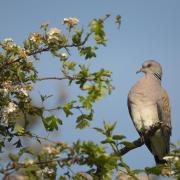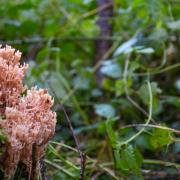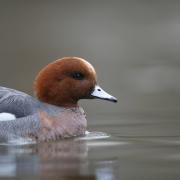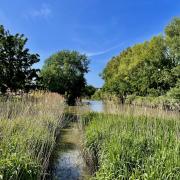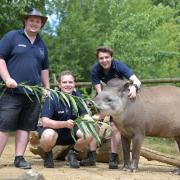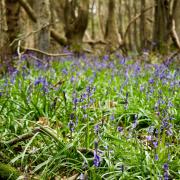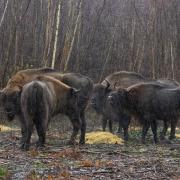If the rather cold, rather soggy march of winter sends shudders down your spine, spare a thought for our garden wildlife...
Like it or not, winter is on the way - the clocks are going back, the first frost is looming. As we curl up on the sofa and draw the curtains tight, Kent's garden birds will be hunkering down with only one thing on their minds: survival.That's why 24 October is RSPB Feed The Birds Day, the chance to fill up those feeders, clean those bird tables and put some water out before the winter weather takes hold. This time of year is tough for birds. Every day, they have to find enough food to fuel them overnight. If they don't, they'll starve before dawn.Tasty treats like fatballs and seed mixes in birdfeeders or on bird tables can provide birds with the energy they need to survive the cold, but there are many ways you can provide a meal without spending anything extra.Blackbirds and wrens are partial to a bit of grated cheese, whereas blue tits go potty over scraps of unsalted bacon - and if you fancy seeing a robin in time for Christmas, small pieces of fruit are the way to go. Your garden can also provide plenty of natural food and shelter, from leaving a patch of grass long to attract insects for birds like house sparrows to eat, a species that has declined by two thirds since 1979. It's not only house sparrow that has declined; the average number of birds seen in gardens has dropped by a fifth since 2004. That's why the RSPB launched Homes for Wildlife two years ago, offering free, tailor-made advice on what you can do with your garden to help wildlife. One of the main reasons house sparrows are declining is a lack of insects available to them when chicks hatch. There are loads of plants you can buy that are great for insects, or you could create a log pile - or try a berry bearing shrub or a fruit tree; now is the perfect time to plant them.Leaving a few piles of leaves in the odd discreet corner will attract the last snails of the season before their hibernation begins, a sure-fire way to attract snail connoisseurs - although some have a sneaky way of getting their fill. Blackbirds, for instance, aren't expert snail-breakers, so they'll listen for the sound of song thrushes cracking snail shells, and then set about robbing the spoils. When it comes to winter food, the prize for the most ingenious birds has to go to jays. One of our shyest birds, they spend most of the year hidden away in woodlands but about now, they'll come into the open, on the hunt for oak trees to find acorns. Jays have great memories; older birds will know where all the local acorn spots are and will make a beeline for them. Once they've spotted an oak tree, a jay will grab as many as 10 acorns in one go, swallowing them into their crop until their throat is bulging. A single jay may hoard up to 5,000 acorns in one autumn, travelling more than 100 miles and working up to 10 hours a day at peak season. They'll hide one or two acorns at a time under leaves, moss or in natural holes. The tit family also has the collecting urge, as do nuthatches and woodpeckers. Now that the breeding season is over, the risk of baby birds choking on whole peanuts has gone, so if you have started putting out these tasty treats it can come as a surprise to see the local great tit appearing to plant them in your flower border.Tits don't have quite the memory capacity of jays and will usually return to their store within hours or days, but the technique is impressive, nevertheless.These strange goings-on could be happening right outside your window, and the more varied the food you provide, the more antics you're likely to see. Feeding wildlife can give hours of enjoyment.
Fun bird recipes for kids of all ages!
CRUMBLE PASTRY MAGGOTSPut 150 g of flour in a bowl and mix in 50 g of margarine with your fingers. You will find the dry mixture will rub into little bits that look like maggots. Sprinkle the maggots on the ground, bird table and among bushes or flowerbeds. Attracts robins, tits and blackcaps on the bird table; dunnock, wren, or wagtails on the ground.
SPEEDY BIRD CAKEIn a bowl, mix peanut pieces, raisins and grated cheese into good quality birdseed. Cut 85 g of fat (vegetable or lard), which has been left in a warm place for about an hour, into small pieces. Rub it evenly into the seed mixture using your fingertips (there's no need to melt the fat as suggested in most recipes) To hang up the mixture, get an empty yogurt container and make a hole in the bottom. Make a knot in a length of string and thread it through the hole until the knot holds it in place. Empty the cake mixture into the pot and leave it in the fridge to set for an hour before hanging outside. Great for tits, greenfinches and great spotted woodpeckers.
MONKEY NUT KEBABSYou will need a wire coathanger, peanuts in their shells, wire cutting pliers, a piece of string. Use the pliers to cut a straight piece of wire, around 30 cm long, from the coat hanger. Curl the wire over so you have a loop at one end so that it looks like a kebab skewer. Carefully push on as many monkey nuts as you can. When the wire is full, bend the end round into another loop to stop the peanuts falling off. Thread string into the loop and hang up the monkey nut kebab. Attracts blue tits, coal tits, great tits and nuthatches.



